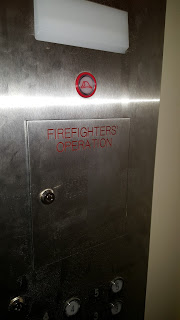I
have wanted to share this information for some time. This is the history of Elevator Firefighters
Emergency Operation. It is interesting
on how the elevator code requirements have changed over the years in reactions
to different events. The big event that
escalated adoption and alternate floor recall was a fire at the MGM Grand Hotel
and Casino in Las Vegas Nevada in 1980.
Significance of MGM
fire -
The burning material created toxic
fumes and smoke, which ascended throughout the hotel tower via vertical shafts
(elevators and stairwells) and seismic
joints and caused the majority of
the deaths. Firefighters reported
having to crawl through the dark and over "mounds of stuff" trying to
extinguish the fire, it was later determined that the "mounds" were
deceased guests and staff near an elevator bank. Proper evacuation of the hotel guests was
hindered as there was no automatic means of returning elevators to the main
floor during a fire, causing 10 deceased victims to be found in an elevator. Survivors recounted how some in the hotel had
tied bedsheets together and hung them on balconies in an attempt to escape
upper floor rooms and alert first responders.
*wikipedia.org
Definitions
Phase I – Phase I is the key
switch that is in the main lobby/egress floor that can be operated by competent
persons[elevator personnel, fire fighters trained in FEO and/or other people
that have had the proper training as outlined in the elevator code. This key switch will recall the elevators to
the main egress.
Phase II – Phase II is the key
switch that is in the elevator that allows competent persons to take control
the elevator, typically fire fighters.
Automatic recall – Automatic recall is
a trigger that will send the elevator down to a specified floor when a device
is set off[smoke, flow switch or approved device].
Alternate landing – Alternate landing is
the feature that allows the elevator to land at a non-fire floor; I.e. if the
fire is at the main landing the elevator will go to the alternate
landing[basement or 2nd floor, whichever is better for building
evacuation]. The elevator is hooked up
to fire recall devices at each landing, machine room and at times inside the
hoistway.
History
ASME 17.1-1973
Automatic
Recall introduced in the Supplement.
Phase
I – all elevators with 25 feet or more of travel.
Phase
II – all elevators with 75 feet or more of travel.
ASME 17.1-1981
Phase
II - all elevators with 25 feet or more
of travel.
Audible
signals - Visible signals
Inspection
audible
Machine
Room and Main Floor Smokes Required
Alternate
Floor Recall
ASME 17.1-1984
Phase
II -
Hold position added to switch.
Car
Call Cancel pushbutton added.
ASME 17.1-1987
Firefighters’
Emergency Operation required of all
elevators with 25 feet or more of travel from the Designated landing.
ASME 17.1-1990
In-Car
Firefighters’ Hat jewel.
Phase
I instructions are specific at hallway key switch.
Phase
II instructions are specific in-car.
Phase I instructions
Phase II instructions
ASME 17.1-1992
All
elevators shall have Firefighters’ Emergency Operation no travel exceptions.
ASME 17.1-1996
“Power
Operated” added to in-car instructions.
All
elevators with 80 or more inches of travel shall have Firefighters’
Emergency Operation.
ASME 17.1-1998
Flashing
Firefighters’ Indicator (FFI) with in-car instructions.
ASME 17.1-2000
Reset
added to Phase I key switch.
ASME 17.1-2004
In-Car
Firefighters’ Operating Panel added.
Power
Monitor (Shunt Trip Monitor) added.
ASME 17.1-2005
“Power
Operated” deleted from in-car instructions.
ASME 17.1-2007
Standardized
key (FEO-K1) for all Firefighters’ Emergency Operation key switches.
Take away– As we review the
evolution of FEO we see changes that are made to make the elevator system safer
in the event of a fire. There is a story
and typically a fatality connected to each change in the elevator code. While the chances of fatality/injury at a
building you own, manage, work on, sell to, etc is very small we should all be educating
our selves to make our buildings safer. If
you ever question the cost of safety, look in the mirror or think of your
family and ask “how much is this life worth?”.
Credit – The MGM information
is from wikipedia.org and the FEO history was taken from a document from Joseph
Donnelly PE.
Hey! Sign up for our mailing list! We should be getting a
monthly email going out sometime in Q1 of next year.
If
you have any questions or would like additional information feel free to
contact me at CraigZ@colleyelevator.com or
630-766-7230 ext. 107.
Also
check us out on Instagram @Colleyelevator see what we have been up to.


































